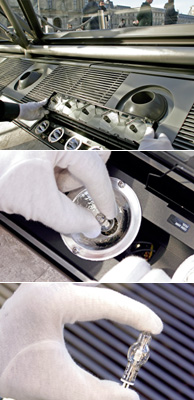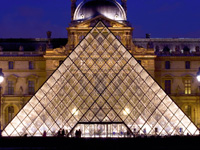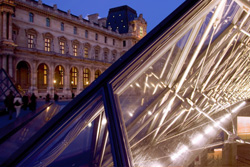Enhancements to the 15-year-old lighting system for the Louvre pyramid bring new sparkle to an iconic structure.
?Designed by I.M. Pei and completed in 1989, the pyramid at the Louvre in Paris is now a familiar symbol of both the museum itself and modern French character. Conceived to connect the old collections and the new auditorium through underground galleries, the emblematic structure is the key entrance for the 6 million visitors that discover the Louvre every year.
Illumination of the glass and steel pyramid was originally entrusted to Maryland-based lighting designer Claude Engle. The client wanted the effect of an object that is illuminated from inside, while avoiding any glare that would limit its transparency. As Engle emphasized in a recent interview, the lighting's purpose was to support the conceptual approach of the architectural composition itself: The pyramid, even though visually oriented on the historical axis of Paris梬hich runs from the Louvre west to La Defense梬ould not interfere with the view of the fa鏰des surrounding it.
Toward this end, Engle, after extensive experimentation, decided to concentrate the light on the steel tensile structure of the pyramid instead of on its glazing. He located the luminaires in a channel around the interior base of the pyramid, setting them in specially designed mounting trays. Each tray contained a series of five modular spotlights, lamped with a 100W halogen source and angled to reveal the intricacy of the load-bearing elements. This solution avoided reflections, establishing a delicate balance between the transparency of the surface and the interior volume.
Fifteen years later, the system was in need of modernization. The client had two goals: to infuse a more contemporary quality to the light emanating from the pyramid to contrast with the warm tone on the surrounding historical fa鏰des; and to reduce the maintenance and cost of the system. Having supplied the custom mounting trays and luminaires for Engle's original design in 1989, Erco was asked by the museum to adapt the lighting system to meet these requests, while maintaining the designer's original concept.

Installed at the end of 2004, the solution was based on newly developed metal halide technology: The 20W lamp from Philips was chosen for its longer life-span (6,000 hours instead of 2,000), reduced power (20W instead of the original 100W) and, consequently, easier maintenance. While the difference in color temperature is slight (from 2700K originally to 3000K currently), it is a perceptibly whiter light. The lamp's dimensions also enabled utilization of the original system's reflector construction, though Erco redesigned the trays to allow grouping of the lamps in sets that could be physically accessible all at once for maintenance. Remodeling the control system with a double circuit enabled the luminaires in each tray to be switched in groups of two or three to adjust brightness. The new housing is also IP44-rated, in order to better handle humidity that has been found to occur inside the pyramid, notes Martin Krautter, marketing director for Erco.
That the recent adjustments to the pyramid's lighting are primarily technical is a testament to the strength of Engle's approach almost two decades ago. "It's definitely the original design," says Krautter, "only with better materials." aurelia duplouich
Aurelia Duplouich graduated from the Versailles School of Architecture, and has a masters in Urban Design from the Bartlett. She contributes regularly to publications in French and English.
DETAILS
project Pyramid at the Louvre, Paris
client Mus閑 du Louvre, Paris
architect Pei, Cobb, Freed & Partners, New York
lighting designer Claude Engle, Chevy Chase, Maryland
photographer Thomas Pflaum, Castrop-Rauxel, Germany
manufacturers Erco, Philips
applications Custom mounting trays and reflectors, 20W metal halide lamps





